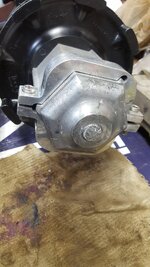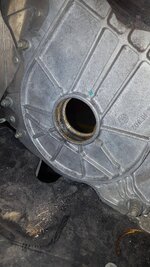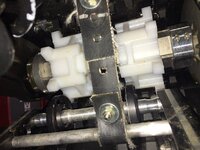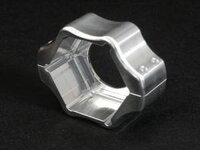Hi all, first post from a background lurker here. This will be a long post. I had considered reviving an existing related post but decided against it. Family has been riding Polaris machines for decades. 50,000+ trouble free miles across 7 machines. The only rebuild to speak of was a 97 XLT at 12,500 miles on the od and that was by choice. We have on 06 Fusion 600 with 9000 miles that will get a rebuild this summer, but anything that we've owned from new, and done the initial break-in ourself, has been rock-solid.
I made my first mountain trip in Feb/19 with my 14 Pro-R 800. I knew once I had one trip under my belt I'd be buying a proper mountain sled. After that trip I bought a used 2013 Pro-RMK with 800 miles on it and put about 200 on around home last spring before the snow disappeared. Headed to Golden with it in Dec/19 and blew the motor on day 2. This was our first ever forced rebuild. Eventually diagnosed it as a seized con-rod bearing. While having that repaired, we found the dreaded left side driveshaft issues. Shaft spun in the bearing and wore itself down. This was 3 days before a planned trip in Feb/20. We didnt have time to source a replacement so we had it machined/sleeved. Ran the break-in tank of fuel out at home the day before we left, then headed out. On day 2 (again) the machined end of the repaired shaft snapped on a long side-hill pull and i finished the day on the end of a rope, (again).
I have the sled broke down now, with what I'm told is (2) 2015 replacement driveshafts in hand and I'm looking for some feedback from those in the know. The old shaft has a clamp on it. Should I continue to use this clamp on the replacement driveshaft?
Secondly, the sprocket side of both the old and new driveshafts has a threaded depth of 1 1/8th" for the retaining bolt. From my reading, I thought the 14+ had a deeper well, allowing for a longer bolt? Regardless, I intend to use as long of a bolt as possible to get the fullest thread engagement as I can.
While removing the old driveshaft, with the drive sprocket side still fully engaged in the bearing that was still snap-ringed in the housing, the left side of the driveshaft would not align with the bearing mounting access hole for easy removal. Looking at it from the left side of the sled, the driveshaft was making contact at approximately the 4:30 position. I had to use pry bar to gently pull it into alignment with the hole so that I could fully remove the shaft. At that, I had to keep the bar on it while another person tapped it on the sprocket side to get it removed.I would have expected a little better alignment. Is it possible that the (pictured) mounting plate that retains the bearing on the sprocket side was bent or warped somehow? It seems like a fairly well reinforced and ribbed piece. I wouldnt think it could/would bend or warp. If my written explanation isnt fully illustrating my question, I will mock up the new/replacement parts and take another picture to demonstrate how far off it was.
It seems like a fairly well reinforced and ribbed piece. I wouldnt think it could/would bend or warp. If my written explanation isnt fully illustrating my question, I will mock up the new/replacement parts and take another picture to demonstrate how far off it was.
Hopefully you guys arent so sick of talking about these issues on the 13's that you dont want to discuss it more. Thanks in advance.
I made my first mountain trip in Feb/19 with my 14 Pro-R 800. I knew once I had one trip under my belt I'd be buying a proper mountain sled. After that trip I bought a used 2013 Pro-RMK with 800 miles on it and put about 200 on around home last spring before the snow disappeared. Headed to Golden with it in Dec/19 and blew the motor on day 2. This was our first ever forced rebuild. Eventually diagnosed it as a seized con-rod bearing. While having that repaired, we found the dreaded left side driveshaft issues. Shaft spun in the bearing and wore itself down. This was 3 days before a planned trip in Feb/20. We didnt have time to source a replacement so we had it machined/sleeved. Ran the break-in tank of fuel out at home the day before we left, then headed out. On day 2 (again) the machined end of the repaired shaft snapped on a long side-hill pull and i finished the day on the end of a rope, (again).
I have the sled broke down now, with what I'm told is (2) 2015 replacement driveshafts in hand and I'm looking for some feedback from those in the know. The old shaft has a clamp on it. Should I continue to use this clamp on the replacement driveshaft?

Secondly, the sprocket side of both the old and new driveshafts has a threaded depth of 1 1/8th" for the retaining bolt. From my reading, I thought the 14+ had a deeper well, allowing for a longer bolt? Regardless, I intend to use as long of a bolt as possible to get the fullest thread engagement as I can.
While removing the old driveshaft, with the drive sprocket side still fully engaged in the bearing that was still snap-ringed in the housing, the left side of the driveshaft would not align with the bearing mounting access hole for easy removal. Looking at it from the left side of the sled, the driveshaft was making contact at approximately the 4:30 position. I had to use pry bar to gently pull it into alignment with the hole so that I could fully remove the shaft. At that, I had to keep the bar on it while another person tapped it on the sprocket side to get it removed.I would have expected a little better alignment. Is it possible that the (pictured) mounting plate that retains the bearing on the sprocket side was bent or warped somehow?
 It seems like a fairly well reinforced and ribbed piece. I wouldnt think it could/would bend or warp. If my written explanation isnt fully illustrating my question, I will mock up the new/replacement parts and take another picture to demonstrate how far off it was.
It seems like a fairly well reinforced and ribbed piece. I wouldnt think it could/would bend or warp. If my written explanation isnt fully illustrating my question, I will mock up the new/replacement parts and take another picture to demonstrate how far off it was.Hopefully you guys arent so sick of talking about these issues on the 13's that you dont want to discuss it more. Thanks in advance.








